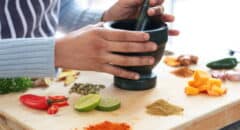If you’re like most people, the thought of snacking comes along with a bit of trepidation. You believe that snacking can be a part of a healthy lifestyle. Still, you also associate snacking with less-healthy choices such as chips, crackers and cookies.
The truth is, snacking can actually be part of a healthy lifestyle, and just about any food can be a snack food—not only those less-healthy items.
The Benefits of Snacking
Research indicates that people who eat smaller, more frequent meals throughout the day are less likely to be obese or overweight. And that’s not all, other health benefits include:
- Sustained energy throughout the day — Snacking helps your body refuel after bouts of exercise and physical activity
- Blood glucose (also called blood sugar) control — People with type 1 or type 2 diabetes may have better control of blood sugars, and decrease the risk of hypoglycemia when eating one or two snacks daily
- Improved overall quality of the diet — Snacks can supply the body with nutrients like calcium, fiber and phytonutrients that might be low in your diet
- Controlled hunger — Snacking between meals can curb your intermittent cravings and prevent you from overeating at mealtime.
Smart Snacking
Snacking can be a challenge when you are eating mindlessly. If you eat when you are not hungry or out of emotion, you are indeed eating mindlessly. Typically, when doing so, your food choices are high calorie, low nutrient foods, which are often referred to as empty calorie foods.
Smart snacking begins with being mindful about your hunger, and then making a healthier choice. Healthy snacks are low calorie, high nutrient foods—known as nutrient dense foods. These give you more bang (nutrients) for your buck (calories). Foods with 20% or more of the Daily Value for a vitamin or mineral are an excellent source, and are nutrient dense.
Additionally, counting carbohydrates can help you plan your snacks, and will serve to keep your blood sugar under control. Look for snacks with no more than 200 calories, 15-to-20 grams of carbohydrates and less than 5 grams of sugar. Add a little fat and protein, and you’ve got the perfect snack!
Here are 15 diabetes-friendly snack ideas to get you started:
- One tablespoon of peanut butter, spread on slices of a medium apple
- One cup of tomato soup, with five whole-grain crackers
- Three cups of air-popped popcorn, sprinkled with three tablespoons of grated parmesan cheese
- A fruit smoothie: Blend 1 cup of fat-free milk, ½ cup of frozen strawberries and ½ of a banana
- Trail mix: ¾ oz bite-sized pretzels, and 10 dry-roasted peanuts
- Nachos: 10 tortilla chips (baked), 1 oz of low-fat cheddar cheese and ¼ cup salsa
- One-half of a small banana, mashed and mixed with 2 tsp of peanut butter, on ½ of a whole wheat English muffin
- Three cups of air-popped popcorn, and 1 oz of dry-roasted almonds
- Seventeen seedless grapes, and 1 oz of low-fat Colby or cheddar cheese
- One hard-boiled egg and 2 tbsps of guacamole
- One-half cup of roasted chickpeas
- One-half cup of low-fat cottage cheese and nine baby carrots
- Three (2 ½-inch) graham crackers, and ½ cup of skim milk
- One cup of plain Greek yogurt, and ½ cup of berries
- One cup of shelled edamame.
 Constance Brown-Riggs is a registered dietitian, and a certified diabetes educator providing virtual nutrition counseling and consultation. She is the author of the Diabetes Guide to Enjoying Foods of the World, and the African American Guide to Living Well with Diabetes. Follow Constance on Instagram, and Twitter @eatingsoulfully.
Constance Brown-Riggs is a registered dietitian, and a certified diabetes educator providing virtual nutrition counseling and consultation. She is the author of the Diabetes Guide to Enjoying Foods of the World, and the African American Guide to Living Well with Diabetes. Follow Constance on Instagram, and Twitter @eatingsoulfully.









